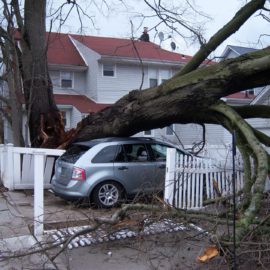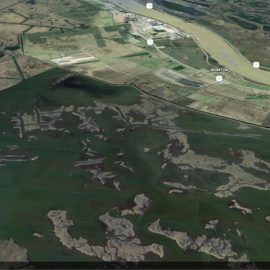
Build levees and protect wetlands.
Louisiana will need to spend billions of dollars on new levees and revive several thousand acres of marshland to protect the coast from what’s expected to be a rough couple of decades, according to an updated 50-year master plan the Coastal Protection and Restoration Authority approved Wednesday. The coastal master plan calls for spending $50 billion on 77 projects that the CPRA hopes will slow the state’s rapid rate of land loss and reduce its vulnerability to hurricanes and rising seas, which are both expected to worsen as the climate changes. The plan has a massive price tag, but failing to carry it out will cost Louisiana much more, according to the CPRA. The plan estimates that the projects will reduce annual storm surge damage by at least $11 billion per year by 2073. “This level of investment could mean that in 50 years … Louisiana would have less flood risk from hurricanes and tropical storms than we do today,” said Stuart Brown, CPRA’s assistant administrator for planning and research. The authority’s board approved the plan unanimously on Wednesday morning.
nola.com
This is the 4th update to the plan.
CPRA board member Simone Maloz called the 187-page document the most “inclusive, responsive and forward-thinking” version of the coastal master plan, which has now been updated four times since it was first adopted by the Legislature in 2007. The updated plan now awaits approval by the Legislature. All three previous plans received unanimous approvals from state lawmakers. The plan’s most expensive project is Morganza to the Gulf, a nearly 100-mile long levee system that will protect the Houma area from storm surges and high-tide flooding. Slated to cost $3.9 billion, the project will shield about 150,000 people in Terrebonne and Lafourche parishes. Another big-ticket item is a $2.4 billion barrier protecting Lake Pontchartrain from storm surge. The project includes gates and dams across The Rigolets and Chef Menteur Pass, which link the salty lake to the coast. The plan revives levee projects that the CPRA had previously decided against. In many areas along the coast, the CPRA had preferred to focus on elevating and flood-proofing buildings rather than building levees and other large-scale projects. But new risk analyses has tilted the authority toward investing more nearly $4 billion in levees around Jean Lafitte and across parts of Iberia, St. Mary, St. James and Ascension parishes. The $1.7 billion Iberia-St. Mary Upland Levee would protect just over 30 miles with a levee designed to withstand surges caused by a hurricane with a 1% chance of occurring in any year – a so-called 100-year storm. It would be built during the plan’s first 20 years. “That project provides a lot of benefits, but I don’t think we’d move forward with it for 10 or so years,” Brown said.
Jean Lafitte was out but now in.
In 2017, the CPRA decided against building a 28-mile-long ring levee around Jean Lafitte, citing the high cost and the town’s small population, just under 2,000 people in 2021. But now CPRA supports spending $1.4 billion on raising Jean Lafitte’s present 7.5-foot-high levee to 16 feet, the 100-year-flood level. The plan also calls for spending $730 million on a nearly 40-mile-long levee to protect St. James and Ascension from storm surge and sea level rise, which are expected to increase flood threats from Lake Maurepas. The St. James-Ascension levee would likely be built after 2040. Marsh restoration efforts would get $16 billion, and about $3 billion would be set aside to build wetland ridges, known as land bridges, in the Barataria and Lafourche basins. The updated plan isn’t as optimistic about saving land as past versions. The 2017 plan predicted that about 800 square miles of land could be built or maintained over 50 years. The new plan indicates only about 310 square miles can be saved. Brown says the difference mostly has to do with the authority’s improved ability to predict land loss and growth. “The simple answer is that we’re more confident in the models we have now than the ones we had in 2017,” he said.
There is little change from a draft paper in January.
The approved plan differs little from a draft version released in January. The most significant add-ons are four coastal ridge restoration projects, which are planned for Pecan Island, Cheniere au Tigre, Lower Bayou Petit Caillou and Bayou LaLoutre. The plan estimates costs for projects but it doesn’t actually approve any money. Many projects will likely be paid with a combination of federal, state and local dollars. The state has managed to put about $1 billion a year toward coastal projects in recent years. CPRA project funding has long depended on the $10 billion from settlements with BP over the 2010 Deepwater Horizon oil disaster, but those funds are expected to run out in less than 10 years. The CPRA hopes to get a larger share of offshore oil revenue under the federal Gulf of Mexico Energy Security Act, which gives the state and coastal parishes 37.5% of offshore revenue from oil and gas production in federal waters. Much of Louisiana’s GOMESA money has gone toward levee and other flood risk reduction projects. An attempt to remove a cap on how much Louisiana and other Gulf states receive under the law died in Congress last year, but CPRA officials are hopeful similar legislation will gain traction this year. Under current cap limits, Louisiana received about $112 million from GOMESA last year.
Doing nothing is not an option.
If none of the projects in the plan were done, Louisiana would likely lose about 1,100 square miles — an area the size of Yosemite National Park — by 2070, according to the CPRA. A more pessimistic scenario indicates nearly three times that much land could be lost, with damages along the coast rising to $24 billion per year. The CPRA board also approved the authority’s largest-ever annual spending plan on Wednesday. While the master plan sets long-term spending goals, the $1.6 billion spending plan for the 2024 fiscal year “is where the money meets the road,” CPRA Executive Director Bren Haase said. The CPRA aims to spend about $27 million more than last year’s plan, with money going to more than 140 projects. Almost two dozen dredging projects would move 77 million cubic yards of river and sea sediment – enough to fill the New Orleans Superdome 17 times. Spread across new marshes and barrier islands, the projects will help revive about 22 square miles of land. “This year’s annual plan outlines the largest annual investment CPRA has ever made,” Haase said. The bulk of the spending, he said, will go directly to building some of the “largest, strongest, and most innovative projects in the history of our coastal program.”
Louisiana’s coastal restoration is the gift that keeps on giving!



